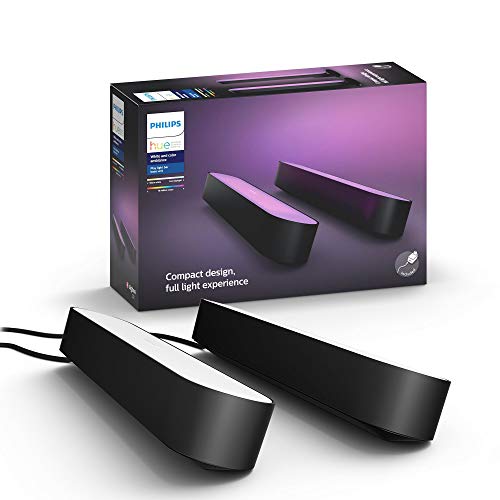If you want to improve the contrast of your TV without ponying up for a brand-new set, bias lighting makes for an easy and relatively inexpensive way to do it. Bias, in this context, means that light is projected at an angle to your TV; more specifically, onto the back of your TV or onto the wall behind it, so that it casts a dim halo around the display.
Once installed, a bias light can boost the apparent contrast of your TV, making blacks and dark areas of the picture look deeper than they did before. Bias lighting can also help ease the strain of looking at a bright TV screen in a darkened room.
Bias lighting for TV sets and computer monitors takes a variety of forms. Most common are peel-and-stick strips of LEDs that adhere to the back of the screen, either in a single strip or on multiple sides of your display. There are also bias lights that sit next to or behind your set, casting a dim (or in some cases, not so dim) light on the wall.
Besides their form factors, some bias lights function differently than others to achieve different effects. The fancier bias lighting systems can sync with the picture on your screen, which makes it look like the colors on your TV are bleeding onto the wall. Other bias lights cast more of a static light, sometimes only white but often with color. Needless to say, there are many schools of thought about which kind of bias lighting for TVs is the best.
Here are our top picks in bias lighting kits for TVs, plus a guide to what to look for when you shop for one. You’ll find a list of our most recent reviews at the bottom of this page.
Best bias lighting for TVs
Developed by the publishers of such oft-used video-calibration discs as Joe Kane’s Digital Video Essentials, The MediaLight TV bias lighting strip is for purists who want to add bias lighting to their home theater setups while preserving the integrity of the picture on their screens. Its adherence to the 6500K color temperature standard as well as its 50-plus steps of brightness earns it our Editors’ Choice award.
Best bias lighting for computer monitors
 Philips Hue Play light bar (double pack)
Philips Hue Play light bar (double pack)Philips took its expertise in smart blubs and applied it to bias lighting, with predictably impressive results. But as much as we liked using the Hue Play bias lights with our TV, we preferred using the twin light bars behind our computer monitor, where their ability to sync with the screen allowed them to shine, quite literally.
How bias lighting boosts your TV’s contrast
Once you’ve set your bias lights to the correct brightness, they can improve the contrast on your TV screen; more precisely, they can boost the perceived contrast on your TV.
Check out this fascinating article on How-To Geek for the nitty-gritty on how this illusion works. In a nutshell, if you take the a single shade of gray, your eyes will see it as darker on a lighter background, and lighter on a dark background. The same principle works when it comes to the colors on a TV screen: In a brightly lit room, the dark areas in a TV’s picture will appear darker than they do in a pitch-black room.
The problem with watching TV in a lit room is that the ambient light tends to rob dark areas in the picture of detail you’d probably see in a dimly lit or completely dark room. In the parlance of videophiles, this loss of detail in darker areas is called “black crush.”
The beauty of bias lighting is that it gives us the best of both worlds. By casting a pale halo behind the TV screen, bias lights can give you enough light around the picture to make dark or gray areas look darker than they would without the bias light. But because bias lights don’t shine light directly on the screen, they don’t hide the details in the shadows.
Careful calibration of your bias lights is the key to boosting your TV’s apparent contrast without crushing dark areas. Ideally, the bias lights should be turned up just enough to improve the perceived contrast, but before the point where you start losing detail. According to some experts, your bias lights should throw off no more than 10 percent of the light that your TV screen does.
Bias TV lighting can ease eyestrain
You’re giving your eyes quite a workout if you’re watching a bright TV screen in a pitch-black room. Again, How-To Geek goes into much greater detail about why, but to simplify things, let’s just say that when you’re watching a bright TV in a dark room, your pupils dilate to accommodate your overall dark surroundings, despite the fact that you’re focusing on a bright picture. The result: eye fatigue, which comes in the form of sore, watery eyes, blurred vision, headaches, or even a sore neck and shoulders (so says the Mayo Clinic).
By casting a dim halo around your TV screen, bias lights are able to boost the overall light level in the room without blowing out your pictures, giving your pupils just enough of a break to keep eyestrain at bay.
Bias lights are great for computer monitors
The TV screen in your living room isn’t the only display that can benefit from bias lighting. If you spend all day looking at a computer monitor, a bias light can do wonders for your eyes, particularly if you’re working in a dark office. And if you’re a PC gamer looking for some extra immersion, look for a bias lighting system that can sync with a desktop system.
6500K is the magic (kelvin) number
Brightness is only one factor when it comes to bias lighting; color is another, and it’s crucial.
If you care about seeing the same image on your screen that the creators of your favorite movies and TV shows intended, the last thing you want to do is distort the colors on the screen. But if your bias lights are red, yellow, blue, green, or some other color besides a precise shade of white, that’s exactly what you’re doing. If your bias light is too warm (think red), you’ll make the picture on your screen look cooler (more blue) than it should, and vice versa.
Ask any professional TV calibrator, and they’ll tell you that bias lights for TVs should be tuned to a color temperature of about 6500K (or, to be more precise, to the D65 color point), which can be roughly described as the color of daylight on a hazy day.
Why 6500K? Because that’s the color temperature that the video industry uses as their standard for what “white” looks like. By using the 6500K standard, videographers and filmmakers can be reasonably sure that (for example) the particular hue of a yellow car in a scene looks the same shade of yellow on your TV as it does in their cameras and monitors.
When shopping for a bias light, be sure to pick one that says it has a 6500K color temperature mode; it’s the easiest way to help ensure that your bias light doesn’t throw off the colors on your screen.
Some bias lights can sync with your display
If you’re looking for an effect that makes your TV screen look like it’s extending onto the wall, consider a so-called “responsive” bias lighting system.
Bias lights that sync with your TV do so in a variety of ways. Some of them connect via HDMI, essentially sitting between a video source and your TV. It’s one of the more precise ways to sync bias lights with your TV picture, but it can also lead to compatibility issues with HDCP-protected video, and you might be limited by number of HDMI inputs your bias lights provide. If it has just one HDMI input, you’ll need to choose whether to use it with your Ultra HD Blu-ray player, your media streamer, your gaming console, or your set-top box for example.
Another method of syncing bias lights with your TV is to use your computer as a go-between, with the lights syncing with video on your PC or Mac that is then mirrored on your TV. Syncing bias lighting via your computer can be as precise as it is over HDMI, but mirroring video on your desktop or laptop computer can be a cumbersome process. And just as with HDMI, copy protection schemes can gum up the works when it comes to syncing bias lights with video on your computer.
A third method of syncing your TV picture with bias lights is by using a camera to scan the screen. The camera might be mounted on your TV and angled so it gets a decent view of your screen, or it could be placed in front of your set, say on a coffee table. Using a camera to sync your bias lights bypasses the issue of copy protection and HDMI inputs, as the camera can scan anything that appears on your screen. That said, you’ll need to deal with the annoyance of installing a camera either on your TV or somewhere in your living room, and the precision of the light syncing might be inferior compared to syncing via HDMI or computer.
No matter which method of syncing a given responsive bias lighting setup uses, lag tends to be a factor, with synced bias lights often a beat or so behind what’s on your TV screen.
Also, remember everything we just said about 6500K and preserving the integrity of the colors on your screen. Needless to say, responsive bias lighting throws all that out the window, with the pulsing colors playing all kinds of havoc with the colors in the picture, not to mention distractions that responsive lights cause.
